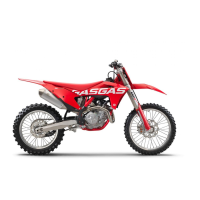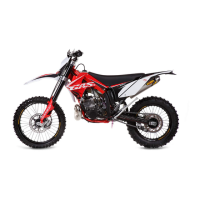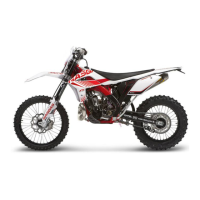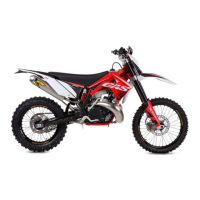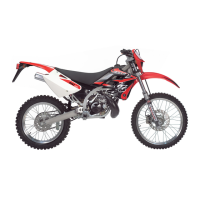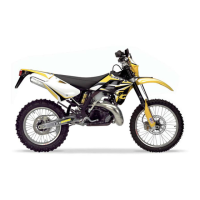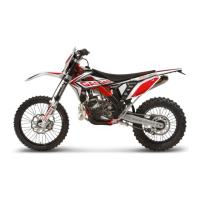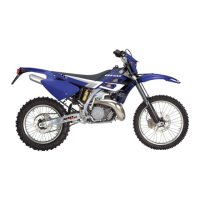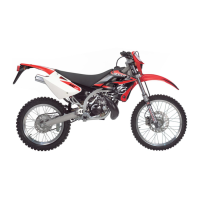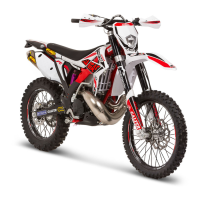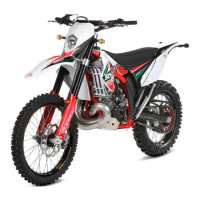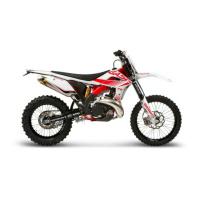Do you have a question about the GAS GAS EC 250 and is the answer not in the manual?
Motorcycle overall dimensions and key measurements.
Details on engine type, bore, stroke, and displacement.
Information on frame type, tires, and suspension basics.
Details on gearbox, clutch, drive system, and ratios.
Information on brake type and disc diameters.
Daily checks for bolts, nuts, and cotter pins for safety.
Specified torque values for critical bolts and nuts.
Information regarding tire types and sizes.
Identification of major motorcycle parts and controls.
Basic introductory information about the motorcycle.
How to operate and use the motorcycle's side stand.
Details on fuel tank, cap, recommended fuel, and fuel tap.
Instructions for mixing fuel and oil for the 2-stroke engine.
Procedures for starting the engine, including choke use.
How to operate the 6-speed transmission and shift gears.
Techniques for decelerating and stopping the motorcycle safely.
Schedule and frequency for regular maintenance tasks.
Spark plug inspection, cleaning, gap adjustment, and replacement.
Procedures for checking and adjusting ignition timing.
Instructions for inspecting, cleaning, and replacing the air cleaner element.
How to inspect and adjust throttle grip free play.
Steps for adjusting idle speed and air/fuel mixture.
How to adjust the clutch lever play for proper operation.
Care for the muffler and silencer, including packing replacement.
Procedures for inspecting, adjusting, and lubricating the drive chain.
How to adjust the handlebar position for rider comfort.
Adjusting brake lever/pedal play and checking fluid levels.
Guidelines for inspecting and changing brake fluid.
Checks and adjustments for steering play and head nut torque.
Overview of methods to adjust front fork performance.
How to equalize air pressure in the front fork legs.
Adjusting the rate at which the fork extends after compression.
Adjusting the rate at which the fork compresses.
Procedure for checking and adjusting front fork oil level.
Adjusting fork springs and clamp position for handling.
Description of the single-shock rear suspension system.
Adjusting rebound and compression dampening on the rear shock.
Procedures for adjusting or replacing rear shock springs.
Adjusting tire pressure for track conditions and rider preference.
Ensuring spokes are tight and checking rim runout.
Inspecting and tightening the tire bead lock clamp.
Safety steps and areas to protect during motorcycle washing.
Steps to take after washing, including drying and lubrication.
Points requiring lubrication according to the maintenance chart.
How to lubricate throttle cables using specialized tools.
Common causes and solutions for engine start problems.
Diagnosing and fixing issues related to fuel/air mixture.
Troubleshooting weak spark, ignition coil, or igniter problems.
Diagnosing poor engine performance, abnormal noises, and vibrations.
Addressing problems with steering, stability, and braking.
Principles and steps for tuning the carburetor for optimal performance.
Adjusting jet needle position and air screw for mixture control.
Factors influencing suspension tuning and adjustment strategy.
Steps for preparing the motorcycle for long-term storage.
Procedures for putting the motorcycle back into service after storage.
Explanation of the multi-function display modes and features.
How to set the time on the digital instrument display.
Motorcycle overall dimensions and key measurements.
Details on engine type, bore, stroke, and displacement.
Information on frame type, tires, and suspension basics.
Details on gearbox, clutch, drive system, and ratios.
Information on brake type and disc diameters.
Daily checks for bolts, nuts, and cotter pins for safety.
Specified torque values for critical bolts and nuts.
Information regarding tire types and sizes.
Identification of major motorcycle parts and controls.
Basic introductory information about the motorcycle.
How to operate and use the motorcycle's side stand.
Details on fuel tank, cap, recommended fuel, and fuel tap.
Instructions for mixing fuel and oil for the 2-stroke engine.
Procedures for starting the engine, including choke use.
How to operate the 6-speed transmission and shift gears.
Techniques for decelerating and stopping the motorcycle safely.
Schedule and frequency for regular maintenance tasks.
Spark plug inspection, cleaning, gap adjustment, and replacement.
Procedures for checking and adjusting ignition timing.
Instructions for inspecting, cleaning, and replacing the air cleaner element.
How to inspect and adjust throttle grip free play.
Steps for adjusting idle speed and air/fuel mixture.
How to adjust the clutch lever play for proper operation.
Care for the muffler and silencer, including packing replacement.
Procedures for inspecting, adjusting, and lubricating the drive chain.
How to adjust the handlebar position for rider comfort.
Adjusting brake lever/pedal play and checking fluid levels.
Guidelines for inspecting and changing brake fluid.
Checks and adjustments for steering play and head nut torque.
Overview of methods to adjust front fork performance.
How to equalize air pressure in the front fork legs.
Adjusting the rate at which the fork extends after compression.
Adjusting the rate at which the fork compresses.
Procedure for checking and adjusting front fork oil level.
Adjusting fork springs and clamp position for handling.
Description of the single-shock rear suspension system.
Adjusting rebound and compression dampening on the rear shock.
Procedures for adjusting or replacing rear shock springs.
Adjusting tire pressure for track conditions and rider preference.
Ensuring spokes are tight and checking rim runout.
Inspecting and tightening the tire bead lock clamp.
Safety steps and areas to protect during motorcycle washing.
Steps to take after washing, including drying and lubrication.
Points requiring lubrication according to the maintenance chart.
How to lubricate throttle cables using specialized tools.
Common causes and solutions for engine start problems.
Diagnosing and fixing issues related to fuel/air mixture.
Troubleshooting weak spark, ignition coil, or igniter problems.
Diagnosing poor engine performance, abnormal noises, and vibrations.
Addressing problems with steering, stability, and braking.
Principles and steps for tuning the carburetor for optimal performance.
Adjusting jet needle position and air screw for mixture control.
Factors influencing suspension tuning and adjustment strategy.
Steps for preparing the motorcycle for long-term storage.
Procedures for putting the motorcycle back into service after storage.
Explanation of the multi-function display modes and features.
How to set the time on the digital instrument display.
| Transmission | 6-speed |
|---|---|
| Starter | Electric and kick |
| Seat Height | 960 mm |
| Engine Type | 2-stroke, single cylinder |
| Displacement | 249 cc |
| Cooling System | Liquid cooled |
| Front Brake | 260 mm disc |
| Rear Brake | 220 mm disc |
| Bore x Stroke | 66.4 mm x 72 mm |
